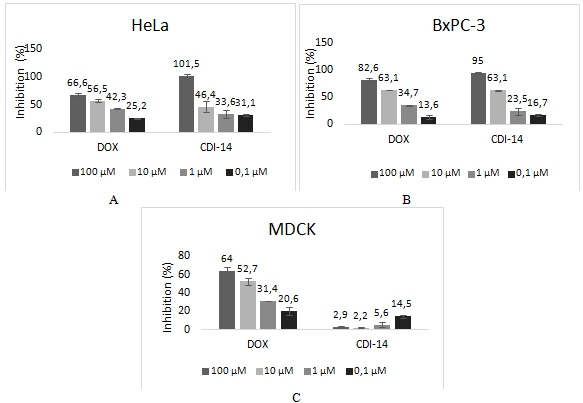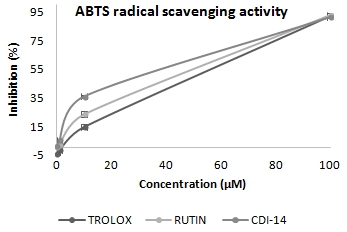ANTIPROLIFERATIVE AND ANTIOXIDANT ACTIVITY OF NITRATO-[4-(3,4-DIMETHYLPHENYL)-2-(2-OXO-3-METHOXYBENZYLIDENE) HYDRAZINECARBOTHIOAMIDO]COPPER
Гуля А.П.1, Гудумак В.С.2, Гарбуз О.С.3, Чеботарь Д.Ю.4, Спыну И.К.5, Пырву О.И.6, Сардарь В.В.7, Тагадюк О.К.8, Гостев И.В.9, Спыну К.И.10, Скоферца П.Г.11
1ORCID: 0000-0003-2010-7959, Доктор химических наук, профессор, академик АН,
Кишиневский Государственный Университет, Кишинёв, Молдова,
2ORCID: 0000-0001-9773-1878, Доктор медицинских наук, профессор,
Государственный университет медицины и фармации им. Н. Тестемицану, Кишинёв, Молдова,
3ORCID: 0000-0001-8783-892X, Аспирант, 4ORCID: 0000-0001-6515-8720, 3,4Молдавский Государственный Университет, Кишинёв, Молдова, 5ORCID:0000-0001-8369-3591, Доктор медицинских наук, 6ORCID: 0000-0001-8045-961X,
5,6Национальный центр общественного здравоохранения, Кишинёв, Молдова,
7ORCID: 0000-0002-1047-9145, Кандидат медицинских наук, 8ORCID: 0000-0002-5503-8052, Доктор медицинских наук,
7,8Государственный университет медицины и фармации им. Н. Тестемицану, Кишинёв, Молдова;
9ORCID: 0000-0001-8913-7414, 10ORCID:0000-0002-9909-5956, Доктор медицинских наук, профессор, 11ORCID: 0000-0002-8209-245X,
9,10,11Национальный центр общественного здравоохранения, Кишинёв, Молдова
АНТИПРОЛИФЕРАТИВНАЯ И АНТИОКСИДАНТНАЯ АКТИВНОСТИ НИТРАТО-[4-(3,4-ДИМЕТИЛФЕНИЛ)-2-(2-ОКСО-3-МЕТОКСИБЕНЗИЛИДЕН) ГИДРАЗИНКАРБОТИОАМИДО] МЕДИ
Аннотация
Мы изучили активность нитрато-[4-(3,4-димети,-лфенил)-2-(2-оксо-3 метоксибензилиден) гидразинкарботиоамидо] меди (CDI-14) нового координационного комплекса класса тиосемикарбазонатов биометаллов, ингибировать рост клеток эпителиальной ткани двух раковых линий, HeLa (аденокарцинома шейки матки) и BxPС-3 (карцинома поджелудочной железы). Также была исследована цитотоксичность вещества в отношении нормальных эпителиальных клеток почки собаки Madin Darby линии MDCK. Жизнеспособность клеток исследуемых линий определяли методом Alamar Blue. В качестве эталона использовали противораковый антибиотик доксорубицин. Антиоксидантную активность оценивали с помощью фотометрического ABTS-метода и сравнивали с показателями эталонов (тролокс и рутин).
Полученные результаты исследуемого вещества указывают на наличие значительного антиоксидантного потенциала и высокой антипролиферативной активности в отношении раковых линий HeLa и BxPC-3. Было выявлено, что исследуемое вещество обладает избирательной активностью, не влияя на цитотоксичность в отношении нормальных клеток линии MDCK, что указывает на его возможное использование в качестве противоракового средства.
Ключевые слова: антипролиферативная активность, антиоксидантная активность, избирательная активность.
Gulea А.P.1, Gudumac V.S.2, Garbuz О.S.3, Cebotari D.Y.4, Spinu I.C.5, Pirvu O.I.6, Sardari V.V.7, Tagadiuc O.C.8, Gostev I.V.9 Spinu C.I.10, Scoferta P.G.11
1ORCID: 0000-0003-2010-7959, PhD in Chemistry, Professor, Academician ASM,
Moldova State University, Chisinau, Moldova,
2ORCID: 0000-0001-9773-1878, MD, Professor,
State University of Medicine and Pharmacy “Nicolae Testemitanu”, Chisinau, Moldova,
3ORCID: 0000-0001-8783-892X, Postgraduate student, 4ORCID: 0000-0001-6515-8720,
Moldova State University, Chisinau, Moldova,
5ORCID: 0000-0001-8369-3591, MD, National, 6ORCID: 0000-0001-8045-961X,
5,6National Center of Public Health, Chisinau, Republic of Moldova,
7ORCID: 0000-0002-1047-9145, MD, 8ORCID: 0000-0002-5503-8052, MD,
7,8State University of Medicine and Pharmacy “Nicolae Testemitanu”, Chisinau, Moldova,
9ORCID: 0000-0001-8913-7414, 10ORCID: 0000-0002-9909-5956, MD, Professor, 11ORCID: 0000-0002-8209-245X,
9,10,11National Center of Public Health, Chisinau, Republic of Moldova
ANTIPROLIFERATIVE AND ANTIOXIDANT ACTIVITY OF NITRATO-[4-(3,4-DIMETHYLPHENYL)-2-(2-OXO-3-METHOXYBENZYLIDENE) HYDRAZINECARBOTHIOAMIDO]COPPER
Abstract
In the present study, the ability of nitrato-[4-(3,4-dimethylphenyl)-2-(2-oxo-3-methoxybenzylidene) hydrazinecarbothioamido] copper (CDI-14) – new coordination compound of the thiosemicarbazone class of biometals to induce the inhibition of proliferation in HeLa and BxPC-3 cancer cell lines was investigated. Its cytotoxicity against MDCK normal cell line was also evaluated. The viability of each cell line was determined by the Resazurin test. Doxorubicin was used as a positive control. The antioxidant activity was evaluated by ABTS assay and compared with those of the standards, trolox and rutin.
Obtained results showed that compound CDI-14 has a good antioxidant potential and high antiproliferative activity against HeLa and BxPC-3 cancer cell lines. It was also observed that the tested compound did not affect the cytotoxic activity of MDCK normal cell line, which indicates its selective toxicity and the possibility of its use as an anticancer agent.
Keywords: antiproliferative activity, antioxidant activity, selective activity.
IntroductionDespite the significant progress made in the anticancer therapy, high systemic toxicity and drug resistance remain a major challenge for modern medicine in the management of cancer. Chemotherapy can produce severe side effects caused by its cytotoxic effect on normal cells. This limits their use and it is an indication for reducing of the drug dose, interruption and even cessation of the treatment [1, P. 2893]. Therefore, it is important that the anticancer drugs to exert antiproliferative and cytotoxic activity in tumor cells without affecting normal tissues.
Free radicals (FR) as highly reactive molecules attack the adjacent stable molecules to obtain an electron. Subsequently, the targeted molecule itself becomes an FR and initiates a cascade of events that can ultimately lead to cellular damage. However, in physiological quantities, FR help to maintain body's homeostasis, acting as signal transducers. FR are also beneficial in the production of some hormones (thyroxin), they are generated to kill some types of bacteria and encapsulated pathogens. Another beneficial activity of FR is the induction of the mitogenic response. Cellular damage occurs when FR meet another molecule and try to extract from it another electron pair for the odd electron. Such FR, unstable due to the electronic deficiency, will capture the missing electron of a neighboring molecule, resulting in the transformation of that molecule into an FR in its turn. The new FR will capture an electron from the following molecule, such a chain chemical reaction occurs in the production of radicals. The formed FR in such reactions ultimately will capture an electron from a molecule that is modified and can no longer function. Such an event leads to the destruction of the molecule and of the cell that contains it. The triggered chain reaction may lead to cross-linking of the atomic structures, as occurs when the reaction involves pair base molecules in a DNA strand. Cross-linking of DNA can cause various aspects of aging, especially cancer.
Thiosemicarbazones represent a class of N, S-donor ligands important in coordination chemistry. Metal thiosemicarbazone complexes [2, P. 189] are a class of substances known for their biological [3, P. 650] and chemical properties, such as antiviral, antibacterial and anticancer activity [4, P. 674].
In this study, we investigated the antiproliferative effects [5, P. 198] of nitrato-[4-(3,4-dimethylphenyl)-2-(2-oxo-3-methoxybenzylidene) hydrazine carbothioamido] copper (CDI-14) - new coordination compound of the thiosemicarbazone class of biometals, which was determined using HeLa human cervical epithelial cell line and BxPC-3 human epithelial pancreatic adenocarcinoma cell line. Since anticancer compound should kill the cancerous cells with the minimal side effects on normal cells so for selective cytotoxicity evaluation, we also exploited MDCK Madin Darby Canine Kidney epithelial normal cell line.
For as much as prooxidant produces adverse modifications to cell components, the anticancer compound [6, P. 44] should not be prooxidant [7, P. 5189]. In that regard, we explored the antioxidant capacity [8, P. 65] of the tested compound CDI-14 by ABTS assay and results were compared with the positive controls (trolox and rutin).
Experiments
- Cell proliferation Resazurin assay
Resazurin (7-hydroxy-3H-phenoxazin-3-one-10-oxide sodium salt) is a non-fluorescent indicator dye, is converted to highly red fluorescent resorufin via reduction reactions of metabolically active cells. The amount of fluorescence produced is proportional to the number of living cells. [9, P. 78].
- ABTS radical cation assay
ABTS assay is an excellent tool for determining the antioxidant activity of hydrogen-donating antioxidants and of chain-breaking antioxidants. The ABTS radical cation scavenging activity was performed with modifications described by Re [10, P. 26].
Results and discussion
The antiproliferative activity of compound CDI-14 and DOX on several cell lines was evaluated by using the resazurin-based microplate assay. Comparative study and concentration ranges identification of cytotoxic activity of tested compound and DOX in regard to HeLa, BxPC-3 cancer cell lines and MDCK normal cell line are shown in Fig. 1.

Fig. 1 – The properties of complex CDI-14 and DOX on the proliferation of some cells of lines after 24 hrs contact: (A) Inhibition of cell proliferation on HeLa line; (B) Inhibition of cell proliferation on BxPC-3 line; (C) Inhibition of cell proliferation on MDCK line
Complex CDI-14 inhibits the creation and growing of cell of lines HeLa and BxPC-3. It was established that CDI-14 shows cytotoxic activity against cells of HeLa and BxPc-3 cancer lines. Thus, the foregoing in vitro study revealed the following IC50 results: HeLa - 3.5±0.5 µМ; BxPc-3 - 4.2±0.9 µM. An important factor is that the complex CDI-14 towards MDCK (Madin Darby Canine Kidney epithelial normal cells) exhibited low cytotoxicity, with IC50 results ≥100 µM. Noting, the research results of DOX cytotoxic activity was identified the following IC50 results: HeLa - 4.8±1.6 µM; BxPC-3 - 3.7±0.3 µM; MDCK - 10.8±0.4 µM. An important point in the study was ascertained by the fact that the complex CDI-14 shows superior inhibitory activity of proliferation on cancer cells of HeLa line than DOX. At the same time, the antiproliferative activity of CDI-14 on BxPC-3 is equivalent to the DOX.
The antioxidant activity of compound CDI-14 and DOX together with the standards trolox and rutin was assessed on the basis of the free radical scavenging effect of the stable ABTS•+ radical. The examined changes in the free radical scavenging ability of the test samples on the basis of percent inhibition are represented in Fig. 2.

Fig. 2 – ABTS•+ radical scavenging activity of trolox, rutin and CDI-14
It was found that compound CDI-14 and reference compounds trolox, rutin exhibited antioxidant activity, with IC50 value of 15.7±0.9, 26.3±0.7, 20.7±0.1 µM, respectively. Analyzing the results of ABTS-method, we observe that compound CDI-14 showed the best antioxidant activity compared with trolox and rutin.
Conclusion
In conclusion, these results suggest that the tested compound CDI-14 is effective in inhibiting proliferation of BxPC-3 pancreatic cancer cells, and exhibits stronger inhibitory activity on HeLa cancer cells than DOX. At the same time this compound exerts low cytotoxic effects on MDCK normal cells, 10 times lower than DOX. The antioxidant study was also supported its antitumor properties. Therefore, compound CDI-14 is particular promising because of its selective toxicity to normal cells, which indicates the possibility of its use as an anticancer agent. However, additional studies are necessary to evaluate the mechanism of action of compound CDI-14 as well as the side effects in other bioassay systems and animal models.
Acknowledgement
We acknowledge Borta Emilia for technical support.
Список литературы / References
- Ferlay J. Estimates of worldwide burden of cancer in 2008: GLOBOCAN / J. Ferlay, H.R. Shin, F. Bray and others // Int J Cancer. – 2010. – Vol. 127. ‑ № ‑ P. 2893-2917.
- Rusnac, R. Sinteza unor tiosemicarbazone in baza N-{4-[(hidrazinilcarconotioil)amino]fenil}acetamidei / R. Rusnac, A. Rusnac, O. Garbuz and others // Studia universitatis moldaviae 6 (96) – 2016. – P.189-194.
- Pahontu E. Synthesis, Caracterization, Antimicrobial and antiproliferative Activity Evaluation of Cu(II), Co(II), Zn(II), Ni(II) and Pt(II) Complexes with Isoniazid-Derived Compound / E. Pahontu, D. Ilies, S. Shova and others // Molecules. – – № 22. ‑ P. 650.
- Pahontu E. Synthesis and Characterization of Novel Cu(II), Pd(II) and Pt(II) Complexes with 8-Ethyl-2-hydroxytricyclo(7.3.1.02,7)tridecan-13-onethiosemicarbazone: Antimicrobial and in Vitro Antiproliferative Activity / E. Pahontu, Paraschivescu, D. Ilies and others// Molecules. ‑ 2016. – № 21. ‑ P. – 674.
- Rusnac A. Sinteza si cercetarea proprietatilor biologice ale unor derivati ai 4-amino-5-metil-4H-1,2,4-triazolului-3-tiol. / A. Rusnac, R. Rusnac, O. Garbuz and others // Studia universitatis moldaviae 6 (96) – 2016. – P.189-194. ISSN 1814-3237 p.198-203
- Pahontu E. Synthesis, characterization, crystal structure and antiproliferative activity studies of Cu(II), Ni(II) and Co(II) complexes with 4-benzoyl-5-pyrazolones derived compounds / E. Pahontu, F. Julea, Chumakov and others // Organomet. Chem. – 2017. – № 836. ‑ P. 44.
- Dilovic I. Novel thiosemicarbazone derivatives as potential antitumor agents: Synthesis, physicochemical and structural properties, DNA interactions and antiproliferative activity / I. Dilovic, M. Rubcic, V. Vrdoljak // Bioorg. Med. Chem. – 2008. – № ‑ P. 5189-5198.
- Gulea A. In vitro antiproliferative activity and antioxidant capacity of new organometallic coordination compounds, rezults correlation analysis / A. Gulea, V. Gudumac, O. Garbuz and others // Buletinul ASM. Stiintele vietii – 2016. ‑ № 3 (330). – P. 65.
- Anoopkumar-Dukie S. Resazurin assay of radiation response in cultured cells / S. Anoopkumar-Dukie, JB Carey, T. Conere and others // British Journal of Radiology. ‑ ‑ P.78.
- Re R. Antioxidant activity applying an improved ABTS radical cation decolorization assay / R. Re, N. Pellegrini, A. Proteggente, A. Pannala and others // Free Radic Biol Med ‑ 1999. ‑ P. 26.
